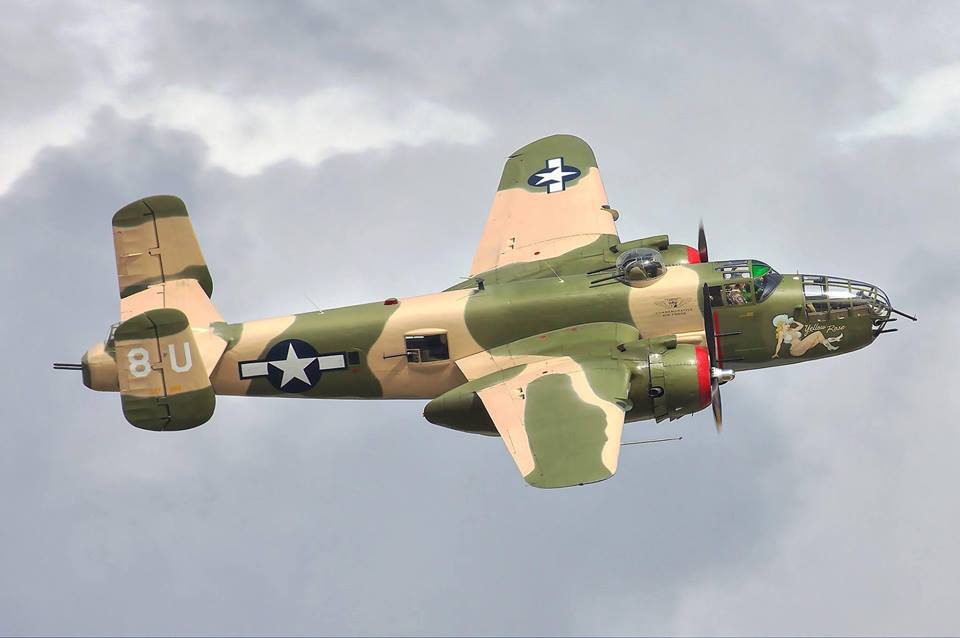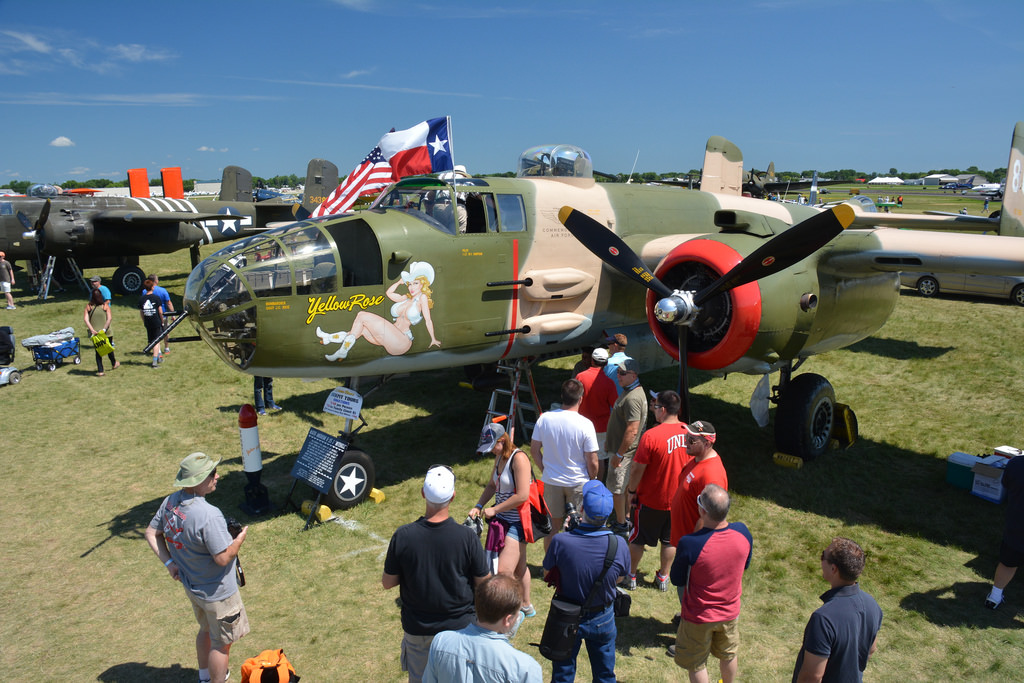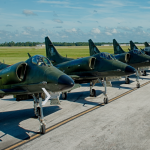On November 3rd, 2017, the Commemorative Air Force’s North American B-25J Mitchell 43-27868 was on final approach during its last airshow appearance of the year when it suffered an engine failure. The crew landed the airplane safely, but upon inspection after shutdown, maintenance personnel determined that the engine would have to be removed and replaced before further flight operations could continue. This particular Mitchell, known famously as Yellow Rose, has been with the CAF’s Central Texas Wing for many years now. With a full 2018 airshow schedule awaiting her, the Central Texas Wing is anxious to get her flying again soon. Their volunteers spent hundreds of hours removing the engine and preparing it for overhaul. However, the process cannot continue until funding for the new engine is secured.
That is where we come in, as the CenTex wing has just started a Kickstarter Campaign to help raise the funds to get Yellow Rose back in the air again, where she belongs! They have dubbed the campaign Operation 107…
Operation 107 seeks to capture the spirit of the short period between the assault on Pearl Harbor and the Doolittle Raid, which sent B-25s like Yellow Rose to strike a counterattack on the Japanese mainland. Telling the story of the Doolittle Raid has long been an integral part of the Yellow Rose mission.
It took 107 days to plan, test, and execute the Doolittle Raid. The Central Texas Wing’s goal is to raise $80,000 for a new engine in the same period of time, harnessing the urgency that made the Doolittle Raid possible so that people can continue to experience this piece of living history.
Please click HERE to help get Yellow Rose flying again!
The CAF Central Texas Wing:
Established at San Marcos Airport in 1974, the Central Texas Wing operates six vintage military airplanes in airworthy condition. These aircraft are housed in an authentic WW II hangar, one of the last of its kind. The Wing also maintains a military aviation museum and library.
Of the thousands of B-25s built during the war, only 27 remain operational in the United States. The Central Texas Wing’s B-25, Yellow Rose, has been a part of the CAF since July, 1979. It was part of the J series, which featured 14-18 machine guns specially positioned for low-flying attacks. Thanks to a complete restoration to wartime condition by members of the Wing, Yellow Rose is the oldest B-25-J currently flying. The bomber now visits an average of 25 cities and towns across the U.S. each year as an educational exhibit dedicated to those who gave their all for the cause of freedom during WWII.
Please click HERE to help get Yellow Rose flying again!
The History of the CAF’s B-25 Yellow Rose:
- 1943: The B-25J-5-NC Yellow Rose, serial number 43-27868, was built.
- Apr. 26, 1944: Yellow Rose was delivered over a year before the end of World War II.
- May 1944: The aircraft was assigned to the 334th Bombardment Medium Group of the Third Air Force. It was later re-allocated to the Army Air Field (AAF) in South Carolina. There were deployments to both Myrtle Beach and Columbia, South Carolina during this period.
- Feb. 1945: Yellow Rose was assigned to the 128th AAF Base Unit of the Continental Air Force at Greenville AAF, South Carolina.
- Dec. 1945: Yellow Rose was assigned to the 112th AAF Base Unit at Hartford AAF, Connecticut.
- Jan. 1946: The aircraft was assigned to the 112th AAF Base Unit at Westover AFB, Massachusetts.
- Feb. 1946: Yellow Rose was placed in storage at the 4168th AAF Base Unit under Air Technical Service Command at South Plains AAF, Texas.
- Jul. 1947: The aircraft was transferred to another storage location at the 4141st AAF Base Unit under Air Material Command at Pyote AAF, Texas.
- Jul. 1949: The plane was removed from storage and assigned to the 3750th Technical Training Wing under Air Training Command as a ground instructional airframe at Shepard AFB, Texas. It remained there for almost seven years without flying, which explains its low airframe time.
- Apr. 1956: The aircraft was flown to the Birmingham Modification Center where Hayes Aircraft Company converted it to a TB-25N and returned it to flying status.
- Jun. 1956: The plane was assigned to the 3640th Pilot Training Wing (ATC) at Laredo AFB, Texas. This assignment included a deployment to Offutt AFB, Nebraska.
- Aug. 1959: The aircraft was returned to storage at Davis-Monthan AFB, Arizona.
- Dec. 11, 1959: Yellow Rose was released by the military and sold to Fogle Aircraft Company of Tucson Arizona.
- Feb. 1960: The aircraft was sold again to Dothan Aviation Corp. of Dothan Alabama.
- Mar. 1960: A civil registration of N9077Z was issued for the plane.
- Jan. 1962: Yellow Rose was modified for agricultural spraying and dusting.
- Oct. 1975: The aircraft was sold to John Stokes of San Marcos Texas.
- Sep. 1977: The aircraft was sold again to Charles Skipper, Charles Becker, and Jack Jones.
- Jul. 1979: Yellow Rose was purchased by the Confederate Air Force (later known as the CAF), and her registration was changed to the current N25YR.


























